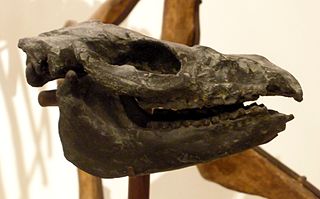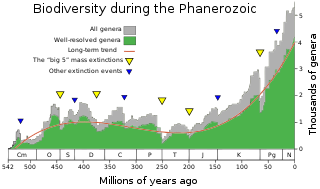Related Research Articles

The Devonian is a geologic period and system of the Paleozoic era, spanning 60.3 million years from the end of the Silurian, 419.2 million years ago (Mya), to the beginning of the Carboniferous, 358.9 Mya. It is named after Devon, England, where rocks from this period were first studied.

An extinction event is a widespread and rapid decrease in the biodiversity on Earth. Such an event is identified by a sharp change in the diversity and abundance of multicellular organisms. It occurs when the rate of extinction increases with respect to the background extinction rate and the rate of speciation. Estimates of the number of major mass extinctions in the last 540 million years range from as few as five to more than twenty. These differences stem from disagreement as to what constitutes a "major" extinction event, and the data chosen to measure past diversity.

The Permian–Triassicextinction event, also known as the Late Permian extinction event, the Latest Permian extinction event, the End-Permian extinction event, and colloquially as the Great Dying, forms the boundary between the Permian and Triassic geologic periods, and with them the Paleozoic and Mesozoic eras respectively, approximately 251.9 million years ago. As the largest of the "Big Five" mass extinctions of the Phanerozoic, it is the Earth's most severe known extinction event, with the extinction of 57% of biological families, 83% of genera, 81% of marine species and 70% of terrestrial vertebrate species. It is the largest known mass extinction of insects. There is evidence for one to three distinct pulses, or phases, of extinction.

Tetrapods are four-limbed vertebrate animals constituting the superclass Tetrapoda. It includes extant and extinct amphibians, and the amniotes which in turn divide into the sauropsids and synapsids.

Sagittariidae is a family of raptor with one living species—the secretarybird native to Africa. This single extant species has affected the fossil record of the group by ‘pulling’ the temporal range of the family to the present, an artifact called the Pull of the recent.
Joseph John Sepkoski Jr. was a University of Chicago paleontologist. Sepkoski studied the fossil record and the diversity of life on Earth. Sepkoski and David Raup contributed to the knowledge of extinction events. They suggested that the extinction of dinosaurs 66 mya was part of a cycle of mass extinctions that may have occurred every 26 million years.
In the geological timescale, the Tithonian is the latest age of the Late Jurassic Epoch and the uppermost stage of the Upper Jurassic Series. It spans the time between 152.1 ± 4 Ma and 145.0 ± 4 Ma. It is preceded by the Kimmeridgian and followed by the Berriasian.

Michael James Benton is a British palaeontologist, and professor of vertebrate palaeontology in the School of Earth Sciences at the University of Bristol. His published work has mostly concentrated on the evolution of Triassic reptiles but he has also worked on extinction events and faunal changes in the fossil record.

Tulerpeton is an extinct genus of Devonian four-limbed vertebrate, known from a fossil that was found in the Tula Region of Russia at a site named Andreyevka. This genus and the closely related Acanthostega and Ichthyostega represent the earliest tetrapods.
The Hangenberg event, also known as the Hangenberg crisis or end-Devonian extinction, is a mass extinction that occurred at the end of the Famennian stage, the last stage in the Devonian Period. It is usually considered the second-largest extinction in the Devonian Period, having occurred approximately 13 million years after the Late Devonian mass extinction at the Frasnian-Famennian boundary. The event is named after the Hangenberg Shale, which is part of a sequence that straddles the Devonian-Carboniferous boundary in the Rhenish Massif of Germany.

Global biodiversity is the measure of biodiversity on planet Earth and is defined as the total variability of life forms. More than 99 percent of all species that ever lived on Earth are estimated to be extinct. Estimates on the number of Earth's current species range from 2 million to 1 trillion, of which about 1.74 million have been databased thus far and over 80 percent have not yet been described. More recently, in May 2016, scientists reported that 1 trillion species are estimated to be on Earth currently with only one-thousandth of one percent described. The total amount of DNA base pairs on Earth, as a possible approximation of global biodiversity, is estimated at 5.0 x 1037, and weighs 50 billion tonnes. In comparison, the total mass of the biosphere has been estimated to be as much as 4 TtC (trillion tons of carbon).

Conservation biologists have designed a variety of objective means to empirically measure biodiversity. Each measure of biodiversity relates to a particular use of the data. For practical conservationists, measurements should include a quantification of values that are commonly shared among locally affected organisms, including humans. For others, a more economically defensible definition should allow the ensuring of continued possibilities for both adaptation and future use by humans, assuring environmental sustainability.
Olson's Extinction was a mass extinction that occurred 273 million years ago in the late Cisuralian or early Guadalupian of the Permian period and which predated the Permian–Triassic extinction event. It is named after Everett C. Olson. There was a sudden change between the early Permian and middle/late Permian faunas. Some authors also place a hiatus in the continental fossil record around that time, but others disagree. This event has been argued by some authors to have affected many taxa, including embryophytes, marine metazoans, and tetrapods.

Proterotheriidae is an extinct family of fossil ungulates from the Cenozoic era that displays toe reduction. Despite resembling primitive, small horses, they were only distantly related to them, and instead belonged to the native South American ungulate order Litopterna.

Eotetrapodiformes is a clade of tetrapodomorphs including the four-limbed vertebrates and their closest finned relatives, two groups of stem tetrapods called tristichopterids and elpistostegalids.

The evolution of fish began about 530 million years ago during the Cambrian explosion. It was during this time that the early chordates developed the skull and the vertebral column, leading to the first craniates and vertebrates. The first fish lineages belong to the Agnatha, or jawless fish. Early examples include Haikouichthys. During the late Cambrian, eel-like jawless fish called the conodonts, and small mostly armoured fish known as ostracoderms, first appeared. Most jawless fish are now extinct; but the extant lampreys may approximate ancient pre-jawed fish. Lampreys belong to the Cyclostomata, which includes the extant hagfish, and this group may have split early on from other agnathans.

The evolution of tetrapods began about 400 million years ago in the Devonian Period with the earliest tetrapods evolved from lobe-finned fishes. Tetrapods are categorized as animals in the biological superclass Tetrapoda, which includes all living and extinct amphibians, reptiles, birds, and mammals. While most species today are terrestrial, little evidence supports the idea that any of the earliest tetrapods could move about on land, as their limbs could not have held their midsections off the ground and the known trackways do not indicate they dragged their bellies around. Presumably, the tracks were made by animals walking along the bottoms of shallow bodies of water. The specific aquatic ancestors of the tetrapods, and the process by which land colonization occurred, remain unclear. They are areas of active research and debate among palaeontologists at present.

The Mesozoic–Cenozoic Radiation is the third major extended increase of biodiversity in the Phanerozoic, after the Cambrian Explosion and the Great Ordovician Biodiversification Event, which appeared to exceeded the equilibrium reached after the Ordovician radiation. Made known by its identification in marine invertebrates, this evolutionary radiation began in the Mesozoic, after the Permian extinctions, and continues to this date. This spectacular radiation affected both terrestrial and marine flora and fauna, during which the “modern” fauna came to replace much of the Paleozoic fauna. Notably, this radiation event was marked by the rise of angiosperms during the mid-Cretaceous, and the K-Pg extinction, which initiated the rapid increase in mammalian biodiversity.

The Capitanian mass extinction event, also known as the end-Guadalupian extinction event, the Guadalupian-Lopingian boundary mass extinction, or the pre-Lopingian crisis was an extinction event that predated the end-Permian extinction event. The mass extinction occurred during a period of decreased species richness and increased extinction rates near the end of the Middle Permian, also known as the Guadalupian epoch. It is often called the end-Guadalupian extinction event because of its initial recognition between the Guadalupian and Lopingian series; however, more refined stratigraphic study suggests that extinction peaks in many taxonomic groups occurred within the Guadalupian, in the latter half of the Capitanian age. The extinction event has been argued to have begun around 262 million years ago with the Late Guadalupian crisis, though its most intense pulse occurred 259 million years ago in what is known as the Guadalupian-Lopingian boundary event.
Land vertebrate faunachrons (LVFs) are biochronological units used to correlate and date terrestrial sediments and fossils based on their tetrapod faunas. First formulated on a global scale by Spencer G. Lucas in 1998, LVFs are primarily used within the Triassic Period, though Lucas later designated LVFs for other periods as well. Eight worldwide LVFs are defined for the Triassic. The first two of these LVFs, the Lootsbergian and Nonesian, are based on South African synapsids and faunal assemblage zones estimated to correspond to the Early Triassic. These are followed by the Perovkan and Berdyankian, based on temnospondyl amphibians and Russian assemblages estimated to be from the Middle Triassic. The last four LVFs, the Otischalkian, Adamanian, Revueltian, and Apachean, are based on aetosaur and phytosaur reptiles common in the Late Triassic of the southwestern United States.
References
- ↑ D. M. Raup (1979). "Biases in the fossil record of species and genera". Bulletin of Carnegie Museum of Natural History. 13: 85–91.
- 1 2 3 Sahney, Sarda; Benton, Michael (2017). "The impact of the Pull of the Recent on the fossil record of tetrapods" (PDF). Evolutionary Ecology Research. 18: 7–23.
- ↑ Raup, David M. (1972-09-22). "Taxonomic Diversity during the Phanerozoic: The increase in the number of marine species since the Paleozoic may be more apparent than real". Science. 177 (4054): 1065–1071. doi:10.1126/science.177.4054.1065. ISSN 0036-8075. PMID 17840596.
- ↑ J. J. Sepkoski (1981). "A factor analysis description of the Phanerozoic marine fossil record". Paleobiology. 7: 36–53. doi:10.1017/S0094837300003778. S2CID 133114885.
- ↑ Sepkoski, J.J. (1997). "Biodiversity: past, present, and future". Journal of Paleontology. 71 (4): 533–539. doi:10.1017/S0022336000040026. PMID 11540302. S2CID 27430390.
- 1 2 Jablonski, David; Roy, Kaustuv; Valentine, James W.; Price, Rebecca M.; Anderson, Philip S. (2003-05-16). "The impact of the pull of the recent on the history of marine diversity". Science. 300 (5622): 1133–1135. doi:10.1126/science.1083246. ISSN 1095-9203. PMID 12750517. S2CID 42468747.
- ↑ Pimiento, Catalina; Benton, Michael J. (2020-02-19). Cavin, Lionel (ed.). "The impact of the Pull of the Recent on extant elasmobranchs". Palaeontology. 63 (3): 369–374. doi:10.1111/pala.12478. ISSN 0031-0239. S2CID 211572135.
- ↑ Cooper, Roger A.; Maxwell, Phillip A.; Crampton, James S.; Beu, Alan G.; Jones, Craig M.; Marshall, Bruce A. (2006). "Completeness of the fossil record: Estimating losses due to small body size". Geology. 34 (4): 241–244. doi:10.1130/G22206.1 . Retrieved 2022-12-15.
- ↑ Benton, M.J.; Storrs, G. (1994). "Testing the quality of the fossil record: Paleontological knowledge is improving". Geology. 22 (2): 111–114. doi:10.1130/0091-7613(1994)022<0111:TTQOTF>2.3.CO;2.
- ↑ Sahney, Sarda; Benton, Michael J.; Ferry, Paul A. (2010-08-23). "Links between global taxonomic diversity, ecological diversity and the expansion of vertebrates on land". Biology Letters. 6 (4): 544–547. doi:10.1098/rsbl.2009.1024. PMC 2936204 . PMID 20106856.
- ↑ Kalmar, Attila; Currie, David J. (2010). "The Completeness of the Continental Fossil Record and Its Impact on Patterns of Diversification". Paleobiology. 36 (1): 51–60. doi:10.1666/0094-8373-36.1.51. ISSN 0094-8373. JSTOR 25609443. S2CID 85642799.